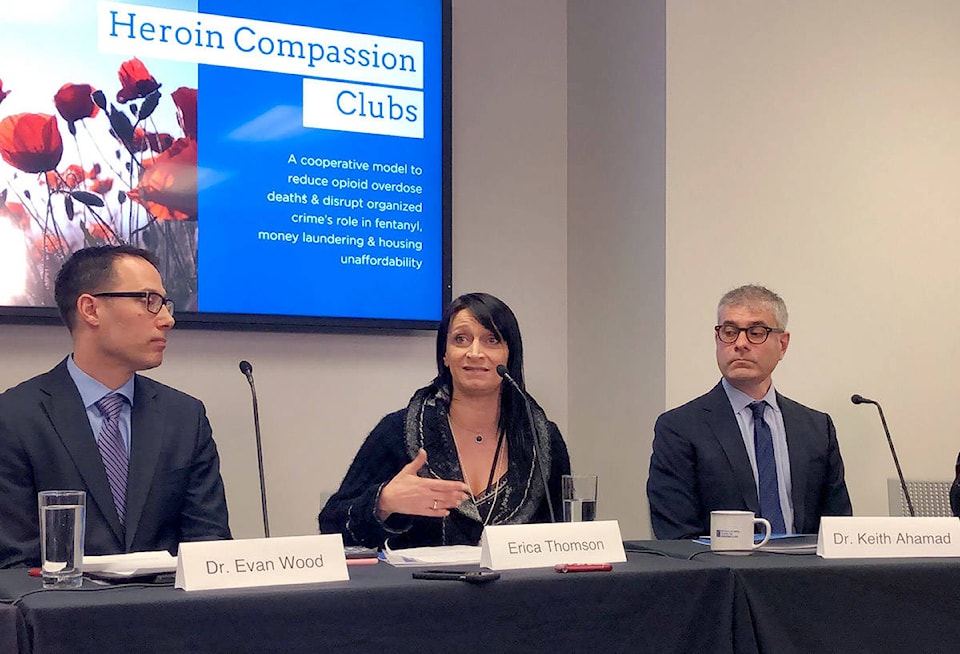Legally regulated heroin sales is the next step needed to curb the staggering number of overdose deaths in B.C. – a majority of which were caused by illicit fentanyl, a new report says.
The report, released Thursday by the B.C. Centre on Substance Use, includes findings from public health researchers, addictions specialists and people with experience of substance use and recovery.
Dr. Evan Wood, executive director at the Vancouver-based centre, told reporters that fentanyl poisonings, money-laundering affecting the housing market, and organized crime are “fraying” the province.
“As an addiction medicine physician and someone who has spent my career studying solutions to the challenges of addiction, I believe the only path forward for better preventing and treating opioid addiction is to wage economic war on organized crime and to regulate and control the heroin market,” Wood said.
Dr. Evan Wood, executive director for @bccsu, at the unveiling of a new report recommending legally regulated heroin sales to curb fentanyl-related overdose deaths plaguing the province. #bcpoli @BlackPressMedia pic.twitter.com/wn2ubRW1ag
— Ashley Wadhwani (@ashwadhwani) February 21, 2019
There have been nearly 3,000 deaths from illicit drug overdoses in B.C. since 2017, with roughly 85 per cent caused by illicit fentanyl.
The report recommends the province establish “heroin compassion clubs” to fentanyl-addicted people access to non-fentanyl-adulterated heroin. These clubs would be located near treatment facilities, and potentially involve recommended training for naloxone kits, which are used to reverse overdoses.
Health Canada would need to approve the model, by providing an exemption either to the Controlled Drugs and Substances Act for research or public health reasons or through another regulation that has allowed B.C. to import injectable pharmaceutical-grade heroin from Switzerland.
READ MORE: B.C. opioid overdoses still killing four people a day, health officials say
READ MORE: New in-depth report sheds light on who in B.C. is dying of drug overdoses
Wood said at least one Vancouver pharmaceutical company that has voiced interest in manufacturing medical-grade heroin. The Crosstown Clinic is the only clinic in the country approved to run a provincially-funded heroin maintenance program. Roughly 130 patients are using injectable diacetylmorphine – the active ingredient in heroin.
Dean Wilson was 13 when he first started using heroin. He went through 50 years of drug use before moving to treatment, now relying on methadone.
“I’ve lasted, I’ve made it through, but what’s killing me is that all my friends are dying,” said Wilson, who is now a peer-support worker at the centre. “If this was car accidents, speeds would be reduced to five kilometres an hour.”
The revenue generated through sales in a compassion club model would be redirected in-house to provide access and supports for the most vulnerable, Wood said.
B.C.’s provincial health officer and chief coroner both called for the federal government to allow the province to offer access to legal heroin earlier this month.
“We have certainly had many conversations with the federal government on the issue of decriminalization,” said Minister of Mental Health and Addictions Judy Darcy on Thursday after receiving the report. “They aren’t showing a lot of appetite for that at the present time.”
Mental Health and Addictions Min @DarcyJudy says she supports prescription #heroin but proceeding carefully #bcpoli #opioids pic.twitter.com/KDsMgjb2DP
— Tom Fletcher (@tomfletcherbc) February 21, 2019
In an email to Black Press Media, Health Canada said it remains committed to working with the provinces and territories to increase access to evidence-based treatment. It also pointed to its providing $1.4 million for a pilot project in B.C. aimed at expanding access to safer alternatives to street drugs.
@ashwadhwani
ashley.wadhwani@bpdigital.ca
Like us on Facebook and follow us on Twitter.



